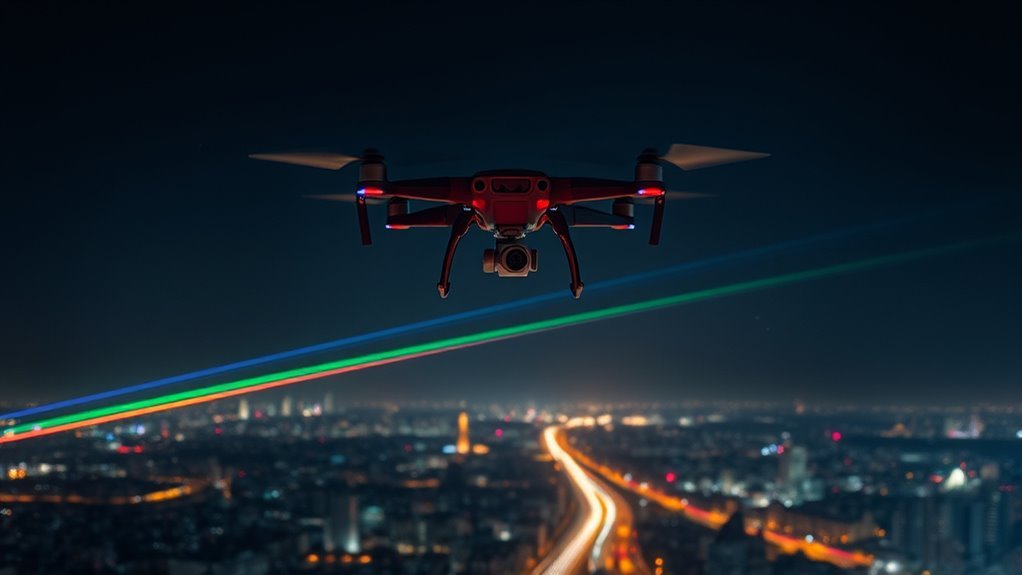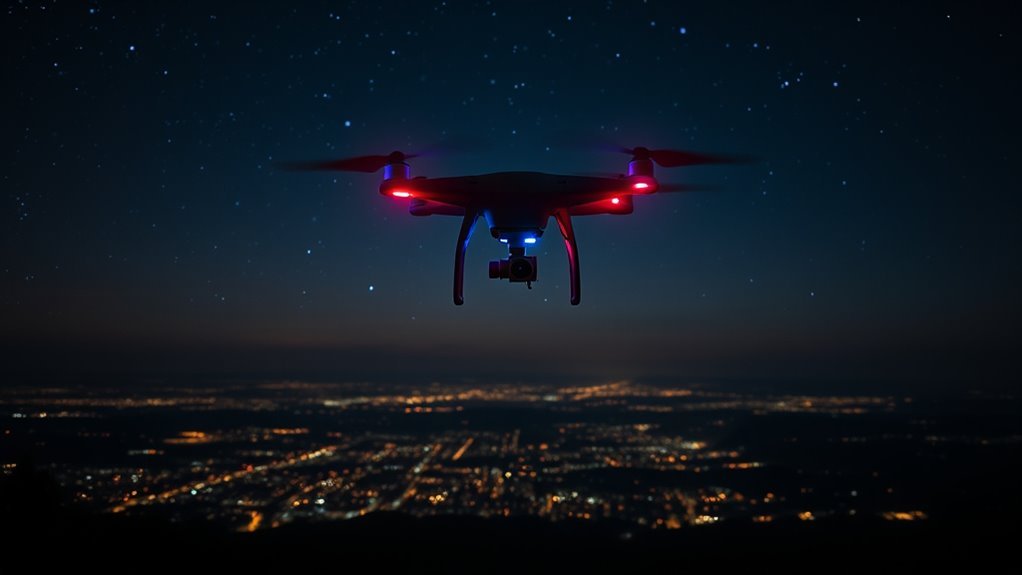Flying drones at night offers significant advantages across various sectors. Enhanced sensors and thermal imaging provide clear surveillance, improving safety and threat detection. In search and rescue operations, drones locate individuals quickly using body heat signatures. Agricultural monitoring benefits from nighttime analysis of crop health. Aerial photography captures stunning visuals in low light, while infrastructure inspections become more efficient. These capabilities showcase the potential of nighttime drone operations, revealing even more benefits that lie ahead.
Enhanced Aerial Photography and Videography

As you explore the capabilities of drones at night, you’ll find that enhanced aerial photography and videography become increasingly accessible and versatile. The integration of advanced sensors and low-light cameras allows you to capture stunning nighttime aesthetics that were once challenging to achieve. You can manipulate exposure settings and ISO levels, enabling creative composition that showcases urban landscapes or natural sceneries under moonlight. The flexibility of drone flight paths offers you opportunities to frame shots from unique angles, enhancing visual storytelling. Additionally, post-processing software can augment these captures, revealing details hidden in darkness. By leveraging these tools, you can create enthralling content that resonates with your audience, providing the freedom to express your artistic vision in ways previously unimaginable. Moreover, the advanced camera capabilities of modern drones enable you to capture clear, detailed images even in dim environments, enhancing dynamic range for richer visual quality.
Improved Surveillance Capabilities

When you utilize drones for surveillance at night, their enhanced night vision capabilities enable you to capture critical details in low-light conditions. This technology allows for greater area coverage, ensuring extensive monitoring without the constraints of traditional methods. Additionally, real-time data transmission provides immediate insights, facilitating swift decision-making in various operational scenarios.
Enhanced Night Vision
While many may associate drones with daytime operations, their enhanced night vision capabilities greatly elevate surveillance performance under low-light conditions. By utilizing advanced thermal imaging and low light sensors, drones can provide unparalleled visibility, ensuring critical details aren’t missed.
- Thermal Imaging: Detects heat signatures, revealing hidden objects or individuals in darkness.
- Low Light Sensors: Amplify available light, allowing for clear imagery in dim environments.
- Real-Time Data Transmission: Transmits live footage, enabling immediate decision-making.
These technologies empower you to conduct thorough surveillance missions at night, enhancing security and monitoring efforts. With these capabilities, you’re equipped to explore and protect areas that were once inaccessible after dusk, reinforcing your sense of freedom in using drone technology effectively.
Greater Area Coverage
Although traditional surveillance methods often limit area coverage due to physical constraints, drones greatly enhance your ability to monitor vast expanses at night. With advanced nighttime navigation systems and aerial mapping capabilities, you can efficiently cover larger areas than with conventional methods. This strategic advantage allows for thorough monitoring, ensuring you don’t miss critical details in expansive environments.
| Capability | Benefit |
|---|---|
| Nighttime Navigation | Enhanced area coverage |
| Aerial Mapping | Detailed terrain analysis |
| Real-time Monitoring | Rapid response capability |
Real-time Data Transmission
Building on the enhanced area coverage provided by drones, real-time data transmission greatly improves surveillance capabilities. With the ability to stream high-quality footage and telemetry instantly, you can react promptly to unfolding situations. This capability guarantees data accuracy and transmission reliability, which are critical for effective decision-making.
Consider the following advantages:
- Instantaneous Feedback: You receive live updates, allowing for immediate tactical adjustments.
- Enhanced Monitoring: Continuous data flow means you can track multiple zones without delay.
- Informed Responses: Real-time analytics facilitate quicker reactions to threats or changes in the environment.
Increased Search and Rescue Efficiency

As search and rescue operations increasingly face challenges in low-light conditions, the integration of drones has proven to enhance efficiency markedly. Utilizing advanced imaging technology, drones provide real-time aerial surveillance, improving your search strategy. They can cover vast areas quickly, identifying potential victims or hazards that ground teams might miss. This capability allows for better rescue coordination, as drones relay critical information to command centers, enabling quicker decision-making. Additionally, drones equipped with thermal imaging can detect body heat, increasing the likelihood of locating individuals in distress after dark. By leveraging drones in your search and rescue missions, you not only expand operational reach but also notably improve the chances of successful outcomes, ensuring that freedom remains a fundamental aspect of emergency response. Furthermore, drones with real-time obstacle avoidance systems can maintain mission integrity without constant oversight, further streamlining operations. The use of two-way communication enhances situational awareness, allowing rescue teams to adapt their strategies based on live data during critical moments.
Agricultural Monitoring After Dark
You can leverage drones at night for enhanced crop health analysis and efficient nighttime pest detection. By utilizing advanced sensors and imaging technology, you’ll gain critical insights into plant conditions that aren’t visible during the day. This capability not only improves monitoring precision but also allows for timely interventions to protect your crops.
Enhanced Crop Health Analysis
While traditional agricultural monitoring often relies on daylight hours, enhanced crop health analysis using drones at night offers significant advantages. By utilizing advanced sensors and imaging technology, you can effectively assess nocturnal growth and identify crop stress without the limitations of sunlight.
- Thermal Imaging: Detects temperature variations indicating plant health.
- Multispectral Scanning: Analyzes chlorophyll levels to evaluate photosynthetic activity.
- Data Integration: Combines nighttime observations with daytime data for thorough insights.
These capabilities empower you to make informed decisions, optimizing your crop management strategies. By monitoring after dark, you can identify potential issues early, allowing you to take action before they escalate, ultimately enhancing yields and ensuring sustainable farming practices.
Nighttime Pest Detection
Effective crop management extends beyond health analysis to include nighttime pest detection, a critical aspect of agricultural monitoring. Utilizing drones for nighttime monitoring allows you to identify pest infestations that would otherwise go unnoticed until damage occurs. Equipped with thermal imaging and advanced sensors, drones can detect the heat signatures of pests, enabling precise targeting for pest control measures. This technology not only enhances your ability to monitor crops after dark but also aids in making informed decisions regarding pesticide application. By utilizing drones for nighttime pest detection, you can improve your overall pest management strategy, reducing crop loss and minimizing chemical usage. Embracing this innovation can considerably enhance your agricultural productivity and sustainability.
Infrastructure Inspections Under Low Light
As infrastructure inspections often require precision and detail, conducting these assessments under low light conditions can pose significant challenges. However, drones equipped with advanced technology can enhance nighttime visibility, ensuring infrastructure integrity remains uncompromised.
Consider the following advantages of using drones for inspections at night:
- High-resolution thermal imaging: Detects heat signatures, identifying potential issues that may not be visible in standard light. Drones like the Wingtra One offer exceptional accuracy, which is crucial when evaluating infrastructure under low light conditions.
- Enhanced LED lighting: Provides clarity and detail, illuminating structures for thorough examination.
- Real-time data transmission: Offers immediate insights, allowing for prompt decision-making regarding maintenance and safety. Additionally, drones like the Hubsan Zino 2+ Pro can provide superior low-light performance with their larger sensors, making them ideal for nighttime inspections.
Nighttime Event Coverage
When it comes to covering nighttime events, drones offer unparalleled advantages, especially in capturing high-quality visuals and providing extensive overviews. You can utilize drones to document nighttime festivals, showcasing vibrant scenes and dynamic activities that would otherwise be challenging to capture. Their advanced cameras excel in low-light conditions, ensuring clarity and detail in every shot. Additionally, drone lightshows enhance the event experience, combining artistry with technology to create stunning aerial displays. Drones can seamlessly navigate through crowds, providing unique perspectives without disrupting the event. This capability allows for thorough coverage, making your documentation of nighttime events not only visually striking but also engaging for your audience. With these tools at your disposal, you truly have the freedom to elevate event storytelling. Moreover, the advanced optics of DJI’s Hasselblad camera redefine low-light photography possibilities, ensuring that even the most intricate details shine through in your night captures. The advanced gyroscopic and electronic stabilization in many drones ensures steady footage, even in unpredictable nighttime conditions.
Wildlife Research and Conservation
The capabilities of drones extend beyond event coverage, playing a pivotal role in wildlife research and conservation. By flying at night, you can gather critical data without disturbing wildlife, enhancing habitat monitoring and species tracking efforts.
Drones revolutionize wildlife research, allowing for undisturbed nighttime data collection that enhances conservation efforts.
- Habitat Monitoring: Drones can capture high-resolution images, allowing you to assess vegetation health and ecosystem changes over time.
- Species Tracking: Equipped with thermal imaging, drones help identify and monitor nocturnal animals, providing insights into their behavior and migration patterns.
- Data Collection: Real-time data collection enables you to respond promptly to environmental changes, ensuring timely conservation actions.
Utilizing drones not only increases efficiency in research but also promotes a sustainable approach to wildlife conservation, allowing you the freedom to protect nature effectively.
Disaster Response and Recovery Operations
While traditional response methods can be hindered by low visibility during nighttime operations, drones equipped with advanced imaging technology have revolutionized disaster response and recovery efforts. Their versatility allows for rapid deployment, enabling you to assess situations from various angles and heights even in darkness. Night navigation capabilities, such as infrared and thermal imaging, facilitate the identification of survivors and hazards without the need for extensive ground-based searches. Drones can deliver essential supplies to inaccessible areas, minimizing delays in aid. By utilizing these aerial tools, you enhance efficiency, reduce risk, and improve outcomes during critical situations. The integration of drones into disaster management not only empowers responders but also guarantees that communities receive timely assistance when they need it most.
Enhanced Safety and Risk Mitigation
Although nighttime operations often pose significant risks to personnel, utilizing drones enhances safety and mitigates those dangers effectively. Drones excel in nighttime navigation, providing real-time data and reducing human exposure to hazards. This technology enables you to conduct thorough risk assessments without compromising lives.
Utilizing drones for nighttime operations significantly enhances safety, allowing for real-time data collection and reducing personnel risks.
- Thermal imaging: Detects heat signatures in low visibility, identifying potential threats. Additionally, drones equipped with advanced obstacle detection technology can navigate complex environments more safely.
- Automated flight paths: Guarantees accurate navigation, minimizing human error during tricky maneuvers.
- Live-streaming capabilities: Allows for instant decision-making and coordination with ground teams. Additionally, drones provide real-time aerial surveillance that enhances situational awareness, allowing teams to respond effectively in emergencies.
Frequently Asked Questions
What Types of Drones Are Best for Nighttime Operations?
For night operations, commercial drones equipped with advanced thermal cameras and powerful LED lights are ideal. These drones enhance visibility and safety, enabling you to conduct operations effectively, even in low-light conditions.
How Do Night Vision Capabilities Enhance Drone Performance?
Night vision capabilities are like a lighthouse in darkness, guiding your drone. With thermal imaging and low light sensors, you’ll navigate unseen landscapes expertly, enhancing surveillance, search-and-rescue, and data collection in environments where others falter.
Are There Specific Regulations for Flying Drones at Night?
When considering night flight regulations, you must adhere to local laws, ensuring compliance with visibility and operational limits. Additionally, securing nighttime drone insurance is essential to protect against potential liabilities during your nighttime operations.
What Safety Precautions Should Be Taken When Flying at Night?
Imagine traversing a starry sky. To guarantee safety, you should enhance nighttime visibility with proper lighting, adhere to operational guidelines, and maintain awareness of surroundings. These precautions keep your flight smooth and secure under the moonlit expanse.
How Do Weather Conditions Affect Nighttime Drone Flights?
Weather conditions greatly impact nighttime drone flights. You’ll face visibility challenges due to reduced light and potential temperature fluctuations that can affect battery performance, requiring careful planning to guarantee safe and effective operation in the dark.

